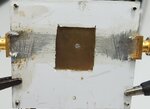volker@muehlhaus
Advanced Member level 6

But once again, is it really serious at 2.4 GHz?
You can add a few nH in simulation and test it. The photo was for the matching circuit input, which is not a 50 Ohm environment. If it is low impedance, inductance matters more than for a high impedance point.
I still don't understand your design workflow, and if/how an error in measured matching circuit (only that, not full circuit) would affect the final circuit.



